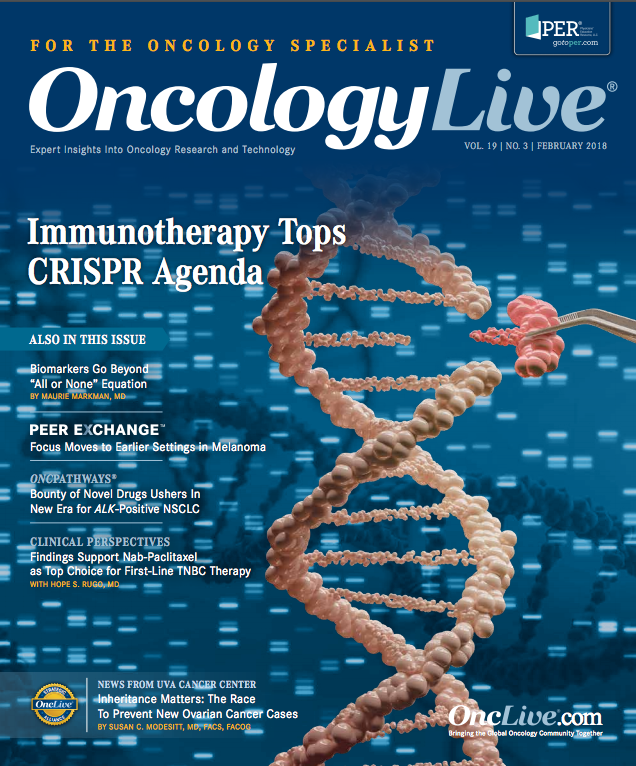Publication
Article
Oncology Live®
Patient Collaboration Can Help Solve "Crisis" in Cancer Care
Author(s):
A factor contributing to better outcomes is better collaboration between physicians and their patients throughout the entire care process.
Lalan Wilfong, MD

Lalan Wilfong, MD
Cancer is a complicated disease that can easily overwhelm patients and their families. Thanks to better screening tools, as well as advanced therapies and treatment options, survival rates for cancer are on the rise. Another factor contributing to better outcomes is better collaboration between physicians and their patients throughout the entire care process.
Cancer care today involves much more than having surgery to remove a tumor or undergoing chemotherapy or radiation therapy treatments. Oncologists are taking a more holistic approach to care that involves psychological, nutritional, social, spiritual, and financial aspects. They also are using new tools and techniques designed to increase patient engagement and enhance shared decision making.
“Patient engagement” is a term used to describe physicians and patients working together to increase a patient’s knowledge about his or her health and willingness to manage his or her treatment. Patients who are engaged ask good questions, understand their disease, and are more likely to follow treatment recommendations and guidelines given to them by their physicians, nurses, nutritionists, pharmacists, and other healthcare providers (TABLE1). They are also better equipped to share in decision making when it comes to treatment options throughout their care journey. Physicians have a better understanding of patient goals and values to align care with the patient’s wishes.
Table. How to Improve Patient Engagement1
Techniques to Improve Communication
In a 2013 report, the National Academy of Medicine stated that national cancer care had reached a state of crisis, noting that a lack of understandable and easily available information on prognosis, treatment options, likelihood of treatment responses, palliative care, psychosocial support, and the costs of cancer care contribute to communication problems.1 To describe and document these facts, oncologists in The US Oncology Network now generate a treatment plan document with each patient whenever a new treatment is started. They print and give a copy to the patient for his or her information and records. This is proving to be a very useful document, not only for the patient and family but also for the other caregivers in the clinic, because the treatment plan serves as a record of the discussion between the physician and the patient on prognosis, treatment, risks, and expected outcomes.Another example of a tool used to increase patient engagement is a program developed and used by oncologists in The US Oncology Network called My Choices, My WishesSM. This program combines specially trained clinicians, carefully crafted educational and resource materials, and healthcare information technology to identify patients, store treatment progress and preferences, define and document directives, and honor patients' wishes throughout their care plan.
My Choices, My Wishes starts with a values assessment with the patient. Patients answer questions pertaining to their healthcare goals and the care they desire during their cancer treatment. This information enables the physician to make treatment recommendations that will best meet the patient’s needs and wishes.
For example, at my practice, we recently treated 2 women with the same type of cancer who had very different concerns. One was single, and her primary wish was to remain independent during treatment. Under no circumstances did she want to move in with her only relative, a sister. The second patient’s main concern was pain management. She wanted to make sure that during treatment, she did not experience significant levels of pain. Independence was not important to her. Knowing and understanding these different primary concerns allowed the care team to recommend and execute a plan that would best meet each patient’s individual needs.
Programs such as My Choices, My Wishes that engage patients in their care planning provide many benefits to the patients. Most importantly, they can improve the patient’s quality of life at each stage of his or her disease. These programs can also prompt patients to make decisions while they still have time to carefully consider and discuss with loved ones what gives their life meaning and purpose, rather than making critical decisions about their care during crisis situations.
Ongoing conversations can help patients and their physicians understand and continually define what is important to the patient, because priorities may change. This becomes especially important in patients with advanced cancer.
Patients who have had these discussions often have a better understanding of their end-of-life care options and may choose to stop ineffective chemotherapy, transitioning to comfort care and focusing on palliative and/ or hospice care. The program can also reduce stress for patients and their loved ones, because the patients make known their values.
A provider never wants to hear patients say that they would have made a different decision regarding their care if they had known more. Good collaboration between providers and patients during the process can help make a cancer diagnosis more manageable and result in better outcomes.
Institute of Medicine of the National Academies. Delivering high-quality cancer care: charting a new course for a system in crisis. National Academies Press website. nap.edu/resource/18359/qualitycancercare_rb.pdf. Published September 2013. Accessed December 2017.










